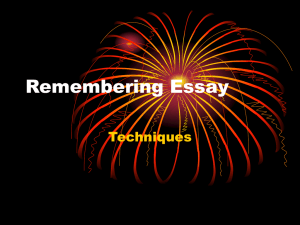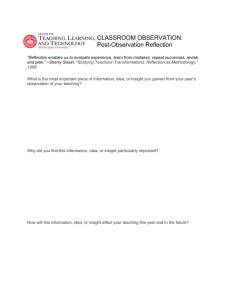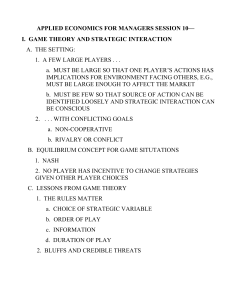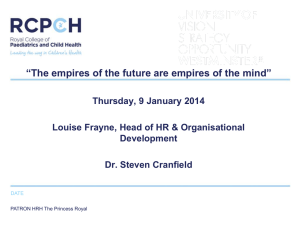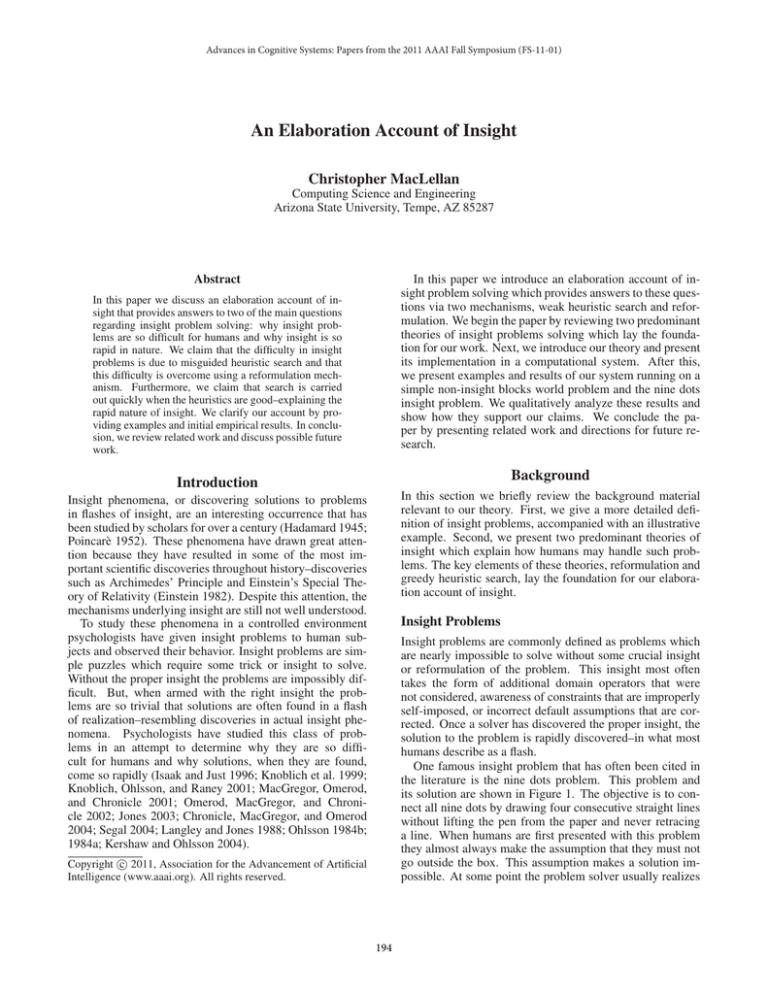
Advances in Cognitive Systems: Papers from the 2011 AAAI Fall Symposium (FS-11-01)
An Elaboration Account of Insight
Christopher MacLellan
Computing Science and Engineering
Arizona State University, Tempe, AZ 85287
In this paper we introduce an elaboration account of insight problem solving which provides answers to these questions via two mechanisms, weak heuristic search and reformulation. We begin the paper by reviewing two predominant
theories of insight problems solving which lay the foundation for our work. Next, we introduce our theory and present
its implementation in a computational system. After this,
we present examples and results of our system running on a
simple non-insight blocks world problem and the nine dots
insight problem. We qualitatively analyze these results and
show how they support our claims. We conclude the paper by presenting related work and directions for future research.
Abstract
In this paper we discuss an elaboration account of insight that provides answers to two of the main questions
regarding insight problem solving: why insight problems are so difficult for humans and why insight is so
rapid in nature. We claim that the difficulty in insight
problems is due to misguided heuristic search and that
this difficulty is overcome using a reformulation mechanism. Furthermore, we claim that search is carried
out quickly when the heuristics are good–explaining the
rapid nature of insight. We clarify our account by providing examples and initial empirical results. In conclusion, we review related work and discuss possible future
work.
Background
Introduction
In this section we briefly review the background material
relevant to our theory. First, we give a more detailed definition of insight problems, accompanied with an illustrative
example. Second, we present two predominant theories of
insight which explain how humans may handle such problems. The key elements of these theories, reformulation and
greedy heuristic search, lay the foundation for our elaboration account of insight.
Insight phenomena, or discovering solutions to problems
in flashes of insight, are an interesting occurrence that has
been studied by scholars for over a century (Hadamard 1945;
Poincarè 1952). These phenomena have drawn great attention because they have resulted in some of the most important scientific discoveries throughout history–discoveries
such as Archimedes’ Principle and Einstein’s Special Theory of Relativity (Einstein 1982). Despite this attention, the
mechanisms underlying insight are still not well understood.
To study these phenomena in a controlled environment
psychologists have given insight problems to human subjects and observed their behavior. Insight problems are simple puzzles which require some trick or insight to solve.
Without the proper insight the problems are impossibly difficult. But, when armed with the right insight the problems are so trivial that solutions are often found in a flash
of realization–resembling discoveries in actual insight phenomena. Psychologists have studied this class of problems in an attempt to determine why they are so difficult for humans and why solutions, when they are found,
come so rapidly (Isaak and Just 1996; Knoblich et al. 1999;
Knoblich, Ohlsson, and Raney 2001; MacGregor, Omerod,
and Chronicle 2001; Omerod, MacGregor, and Chronicle 2002; Jones 2003; Chronicle, MacGregor, and Omerod
2004; Segal 2004; Langley and Jones 1988; Ohlsson 1984b;
1984a; Kershaw and Ohlsson 2004).
Insight Problems
Insight problems are commonly defined as problems which
are nearly impossible to solve without some crucial insight
or reformulation of the problem. This insight most often
takes the form of additional domain operators that were
not considered, awareness of constraints that are improperly
self-imposed, or incorrect default assumptions that are corrected. Once a solver has discovered the proper insight, the
solution to the problem is rapidly discovered–in what most
humans describe as a flash.
One famous insight problem that has often been cited in
the literature is the nine dots problem. This problem and
its solution are shown in Figure 1. The objective is to connect all nine dots by drawing four consecutive straight lines
without lifting the pen from the paper and never retracing
a line. When humans are first presented with this problem
they almost always make the assumption that they must not
go outside the box. This assumption makes a solution impossible. At some point the problem solver usually realizes
c 2011, Association for the Advancement of Artificial
Copyright Intelligence (www.aaai.org). All rights reserved.
194
stuck, resulting in an impasse. When this happens it is theorized that the promising states are then evaluated. Once
all of the promising states have been expanded the process
is repeated with a look-ahead. Upon failure, this process is
repeated with deeper and deeper look-ahead until the solver
eventually finds a solution. In the case where the heuristics
correctly guide the search, the solution is found quickly.
Experimental evidence supports the theory that the difficulty in insight problem solving is due to maximizing and
progress monitoring heuristics (MacGregor, Omerod, and
Chronicle 2001; Omerod, MacGregor, and Chronicle 2002;
Chronicle, MacGregor, and Omerod 2004). This theory
may also explain why insight comes so quickly, due to the
rapid nature of heuristic search. The weakness of this theory lies in its ambiguity regarding how impasses are overcome. Promising states and look-ahead are suggested but
these mechanisms are not studied in the context of impasse
resolution.
Figure 1: The classical nine dots problem and its solution.
this is an incorrect assumption and in a flash of insight a
solution becomes trivial.
The nine dots problem is just one of many insight problems that have been studied in the literature.1 These problems are a mystery that has both intrigued and baffled scholars. If an insight problem is eventually solved, then we know
that the solver has the capacity for a solution. What is the
source of difficulty in finding a solution and why, when a solution is found, does it come so rapidly? These are questions
that any theory of insight should answer.
A Novel Account of Insight
Elements of both the representational change theory and the
criterion of satisfactory progress theory have been corroborated as mechanisms of insight in human studies (Knoblich,
Ohlsson, and Raney 2001; MacGregor, Omerod, and Chronicle 2001; Omerod, MacGregor, and Chronicle 2002; Chronicle, MacGregor, and Omerod 2004) but each theory fails to
tell a complete story about insight problem solving. Representational change theory does not account for the rapid
nature of finding a solution once insight is discovered. Conversely, the criterion of satisfactory progress theory fails to
adequately explain how one overcomes impasses in search.
By combining elements of each theory we can present a
more complete story of insight problem solving. This new
theory, an elaboration account of insight, makes three explicit claims about the insight problem solving process:
1. The primary difficulty in insight problem solving is due
to misguided heuristic search–resulting in impasses.
2. Impasses are overcome by changing the search heuristic
via a reformulation mechanism.
3. Fast search, due to good heuristics, results in the rapid
discovery of a solution.
Together these claims tell a story about insight phenomena and serve as the main contribution of our paper. However, we make no claims as to how a person is reminded of
a problem during the incubation phase2 (a period of rest after a failed attempt) or how a solution, once it is found, is
presented to the conscious mind.3 In the next section, we
present a computational system for solving insight problems
that is consistent with these claims. This system will use iterative sampling and goal elaboration to facilitate solutions
to the nine dots insight problem.
After presenting our implementation we present examples
and experimental results of our system running on a blocks
world problem and the nine dots problem. These initial results are positive and offer support for our claims. We show
Representational Change Theory
Representational change theory (Knoblich et al. 1999) extends from the work of Gestalt psychologists who believed
that the mind uses structures to represent every situation and
that these structures could be reformulated. In this theory it
is believed that one encounters impasses, not knowing what
to do, when attempting to solve an insight problem. Representational change theory posits that these impasses are
overcome by reformulation of the problem representation.
Knoblich, Ohlsson, Haider, and Rhenius present two hypothetical mechanisms to facilitate this reformulation: relaxation of constraints and decomposition of perceptual chunks.
Since previous experience is the source of constraints and
perceptual chunks, they posit that the difficulty in insight
problem solving is due to the challenge of overriding past
experience when faced with new situations. Their arguments
for reformulation are convincing and have been supported
experimentally (Knoblich, Ohlsson, and Raney 2001) but
they fail to offer a convincing story of why solutions come
so rapidly once insight is discovered. They argue that once a
solution found using look-ahead that it presented to the conscious mind but the details of how a solution is found via
look-ahead are not explained.
Criterion of Satisfactory Progress Theory
The criterion of satisfactory progress theory, presented by
Chronicle, Ormerod, and MacGregor (2001), explains the
difficulty in insight problem solving as a result of search
with maximizing and progress monitoring heuristics. The
criterion of satisfactory progress theory posits that when
solving an insight problem, only actions which make adequate progress towards the goal are considered. From this
set of adequate states, the best states are expanded and the
remainder are marked as promising states for later review.
Due to the greedy nature of this search, the solver can get
2 See
1 See
3 See
(Isaak and Just 1996) for a complete list.
195
Langley and Jones (1988) theory of spreading activation.
the work by Ohlsson (2011) .
that misguided heuristic search is the primary difficulty in
solving the nine dots problem. Furthermore, our results
show that reformulation enables our system to overcome
this difficulty. Lastly, we show that the problem, once reformulated, is qualitatively as easy as a simple blocks world
problem–suggesting a rapid solution. It is important to note
that we make no claims regarding exactly which search and
reformulation mechanisms are used by humans. Additionally, we believe that other implementations of weak search
and reformulation, besides the ones we use, may also suffice.
tions which are estimated to be better are more likely to be
chosen.
Our implementation of iterative sampling tries 15 attempts at solving a given problem before reporting a failure.
If in the course of these 15 attempts a solution is discovered,
it is immediately returned.
Search Heuristic The heuristic used by our system is the
number of goal literals satisfied in a given state. A boost is
applied to the heuristic when the number of literals satisfied
is greater than those satisfied in the current state, encouraging progress. This domain independent heuristic is derived
from the goal literals so the heuristic landscape will change
when the goal state is changed.
Implementation
Our implementation of an elaboration account of insight
utilizes a modified version of iterative sampling (Langley
1992) as the weak search mechanism and goal elaboration
with Answer Set Programming (Gelfond 2007) as the reformulation mechanism. These mechanisms, outlined in the
following two subsections, require relational formulations
of any problems we wish to solve.
Together these mechanisms form a complete system that
is capable of solving both insight and non-insight problems.
Given an insight problem, our system will first use modified
iterative sampling, a greedy non-deterministic search, to attempt a solution. Since the goals of insight problems are
only minimally specified, the domain independent heuristics, which are derived from the goal state, initially misguide
search. Since the search is misguided, a solution will be almost impossible as the heuristics will consistently recommend the wrong actions. When the system reaches a certain number of failed attempts, goal elaboration with answer
set programming is employed to infer a more complete goal
statement. When the goal is reformulated and heuristic estimates are improved, a solution comes quickly–hence the
rapid feeling of insight.
Reformulation Mechanism
For our reformulation mechanism we implemented goal
elaboration, a technique which elaborates a given goal
state.4 We chose to use goal elaboration because our search
heuristic is based entirely on the goal. By changing the
goal state the heuristic landscape of the search is modified.
To conduct this goal elaboration we use Answer Set Programming, a logic programming language similar to Prolog.
Our implementation is capable of finding fully specified goal
states for a given problem.5
Goal Elaboration The purpose of goal elaboration is to
turn a partially specified goal state into a more fully specified goal state. We conduct goal elaboration by finding goal
literals that can be inferred from the initial and goal states.
An abstract example can be given in the blocks world domain:
Initial State: ((block A) (block B) (block C)
(on-table A) (on-table B) (on-table C))
Goal State:
((on A B))
From this problem we might infer the additional goal literals
(on-table B) or (on B C), since B must be on something.
Both elaborations in this example are correct and each will
lead the heuristics to recommend different actions to achieve
the goal.
Weak Search Mechanism
For our weak search mechanism we implemented a basic forward chaining planner in the Lisp programming language. This planner accepts problems in a STRIPS (Fikes
and Nilsson 1971) like representation and uses modified iterative sampling as its search technique. Additionally, the
system uses a domain independent heuristic to guide search
and accepts a maximum plan length which limits the depth
of the search.
Answer Set Programming To conduct goal elaboration
we used Answer Set Programming, a logic programming
language which finds the answer set for a given logic program. An answer set is a set of all minimal models that are
consistent with the rules of a given logic program. Thus,
for each problem we wished to reformulate, we describe the
problem in logic rules (including the initial and goal literals)
and use answer set programming to find all minimal models consistent with these rules. Each minimal model corresponds to an elaborated goal. Answer Set Programming has
Iterative Sampling This is a non-deterministic search
technique that uniformly samples actions at each state.
When the maximum search depth is reached or a repeated
state is detected this technique simply gives up and restarts
search from the root node. Unlike depth-first search, backtracking is never performed. This search technique is similar
to progressive deepening, a technique De Groot (1978) has
observed in human chess players.
We use a modified version of this search method which
uses heuristics to aid the search. Instead of uniformly sampling the actions, our version samples from the heuristically
weighted set of actions. Since the probability of selecting
an action is proportional to its heuristic estimate, those ac-
4 We
do not strictly elaborate the goal– in some cases we also
elaborate the initial state.
5 It is not crucial that we find all elaborations for a problem, that
these elaborations are fully specified, or even that they are logically
valid. In fact, we believe exhaustively finding elaborations is an excessive approach. Goal elaboration with answer set programming
simply provides one mechanism by which goals could be reformulated.
196
an option to return the first model that it finds, halting further search. In our implementation we utilize this option, as
we only need one elaboration.
If Answer Set Programming fails to find any models, then
a solution to the problem is impossible. When this happens
generative rules, rules which generate literals, can be used to
infer missing elements. In our model we have a generative
rule for adding additional dots to the problem. A dot in any
row or column under some acceptable limit (up to the 5th
row or column in out example) can be added. These dots
have a constraint that if they are added to the problem then
they must be crossed in the solution which prevents unnecessary dots from being inferred.
As described, Answer Set Programming searches the
space of possible goal elaborations (and initial state elaborations to the extent that the generative rules allow). This
allows us to modify the heuristic estimates without having
to perform search over the space of all possible heuristics.
Table 1: A non-insight blocks world problem.
Max Plan Length: 50
Initial State:
((block A) (block B) (block C)
(on-table A) (on-table B) (on-table C))
Goal State:
((on A B) (on B C) (on-table C))
Action:
Preconditions:
(lift ?x)
((block ?x) (not (on ?any ?x))
(on ?x ?y) (not (holding ?any2)))
((not (on ?x ?y)) (holding ?x))
Effects:
Action:
Preconditions:
Effects:
Effects:
(stack ?x ?y)
((block ?x) (block ?y) (holding ?x)
(not (on ?any ?y)))
((not (holding ?x)) (on ?x ?y))
Action:
Preconditions:
Effects:
(place-on-table ?x)
((block ?x) (holding ?x))
((not (holding ?x)) (on-table ?x))
Action:
Preconditions:
Examples and Experimental Results
In this section we present example runs of our system on
two different problems. Additionally, we provide experimental evidence which supports our claims. We show that
the difficulty in solving the nine dots insight problem lies in
misguided heuristic search. Furthermore, we show that this
difficulty can be eliminated by elaborating the goal. Finally,
we show that performance on the problem, once it has been
reformulated, is equivalent to that of a simple blocks world
problem–a problem humans are capable of solving almost
instantly. This suggests that the rapid nature of insight is
due to heuristically guided search.
First, we present a non-insight blocks world problem. We
show our representation of the problem and an example of
how our system finds a solution. Next, we present the nine
dots insight problem. We show our representation of the
problem and show examples of how our system finds a solution to a version of this problem which has been modified
to enable a solution. After this, we present results from the
system running on the original and modified nine dots problem with various configurations. We finish this section by
discussing the presented examples and how they support our
claims about the insight process.
(lift-from-table ?x)
((block ?x) (not (on ?any ?x))
(on-table ?x) (not (holding ?any2)))
((not (on-table ?x)) (holding ?x))
• (holding ?x), representing that the agent is holding the
block ?x.
• (block ?x), signifying that ?x is a block.
The goal of the problem is to find a plan to move three
blocks sitting on the table into a tower of three blocks. This
simple task is one that most humans will immediately know
the answer to. Later, we will show that the performance on
this task is qualitatively equivalent to the performance on
the nine dots insight problem after it has been reformulated,
giving some measure of how quickly one finds a solution to
an insight problem once a proper reformulation is achieved.
Example Shown in Table 2 is the trace of our system solving the blocks world problem.6 Our system starts off in the
initial state (step 1) with an empty plan. It then samples an
action from the heuristically weighted set of available actions. In step 2 action (lift-from-table A) is selected. This
is the incorrect action (B should be placed on C before A is
placed on B) but our system is unaware of this and continues
search anyway. Next, in steps 3 to 5 the sample and select
action sequence is repeated. Finally, in step 5, after the action is selected, the system realizes that it is in a state that
it has previously visited. This causes the planner to restart,
as shown in step 6. In steps 7 through 10 the system again
follows the sample and select sequence. Upon selecting the
(stack A B) action in step 10 the planner realizes that it has
achieved the goal, causing the system to terminate and return
the current plan.
Non-Insight Blocks World Problem
To provide an illustrative example, we show our system
solving a simple problem from the well known blocks world
domain. Since the problem is not an insight problem, reformulation is not required. Thus, we only show an example
of the system solving the problem with the original goal formulation.
Representation For our blocks world problem we used
the common representation. The problem, shown in Table
1, consists of four relations and four actions. The four relations featured in our problem are:
6 In this trace, and all those following, chosen actions are pushed
• (on ?x ?y), describing that a block ?x is on a block ?y.
onto the front of the plan, so the plans shown in the table are in
reverse order.
• (on-table ?x), meaning that a block ?x is on the table.
197
10
3
2
1
Table 2: A solution trace of our system solving the blocks
world problem.
Step # Current Plan
1
()
2
((lift-from-table a))
3
((stack a b) (lift-from-table a))
4
((lift-from-table c) (stack a b)
(lift-from-table a))
5
((place-on-table c)
(lift-from-table c)
(stack a b) (lift-from-table a))
Failure, repeated state detected
6
()
7
((lift-from-table b))
8
((stack b c) (lift-from-table b))
9
((lift-from-table a) (stack b c)
(lift-from-table b))
10
((stack a b) (lift-from-table a)
(stack b c) (lift-from-table b))
Goal achieved
6
5
4
9
8
7
11
Figure 2: Numerical value of the dots in our nine dots formulation.
needed for a solution. For this reason we also include a
modified version of the nine dots problem which has the two
necessary dots (d10 and d11) and relations for their orientation. We have shown a graphical representation of the dot
orientation and numbering in Figure 2, which also shows
the locations of the additional dots.
Our reformulation mechanism enables a solution to the
original formulation by using generative rules to infer the
missing dots. For this to be achievable an assumption is
made in the Answer Set Programming model that additional dots may need to be inferred. When Answer Set Programming encounters the original formulation the additional
missing dots are inferred, enabling Answer Set Programming to find an elaboration. This elaboration along with a
new modified problem, which contains the inferred dots, is
returned to the solver.
As shown in Table 7, the system had a 100% success rate
on the blocks world problem and averaged 1.13 failed attempts before finding a solution. These numbers provide
a measure of performance on an easy task. Later we will
compare these results with those on the modified nine dots
problem with a reformulated goal.
Example With Original Goal Shown in Table 4 is a trace
from our system solving the modified nine dots problem
with the original goal and no reformulation. In this example
the system starts off incorrectly by choosing to place the pen
at dot 5 (in step 2), an unsolvable situation. At step 6, when
only dot 6 remains uncrossed, the system fails because the
max plan length has been reached. The second attempt starts
off correctly but again fails to find a solution. This pattern
repeats for an additional 13 failed attempts before the system finally reports that it failed to find a solution. Since the
system is not using reformulation in this example, no further
work is performed. In this example the planner experienced
difficulty due to the poor search heuristics which failed to
consistently guide the planner to the correct actions. This
inability to consistently choose the correct action resulted in
the non-deterministic equivalent of a problem solving impasse.
As shown in Table 7, the system had only a 31% success rate on the modified version of the nine dots problem
with the original goal and no reformulation.8 For the 31 successful runs the system averaged 7.32 failed attempts before
finding a solution.9
Nine Dots Insight Problem
To support the claims of our theory we give example traces
and experimental results of our system solving the nine dots
insight problem. We show experimental results of running
our system in three configurations on two versions of the
problem.
Representation There were multiple levels of abstraction
at which we could have represented the nine dots problem.
We chose a high-level representation that still allowed us
to perform sufficient reformulation. The original problem,
shown in Table 3, consists of six relations and five actions.
The six relations from our problem are:
• (dot ?x), signifying that ?x is a dot.
• (three-adj ?x ?y ?z), representing that ?x, ?y, and ?z are
adjacent to each other and in a row.
• (crossed ?x), meaning that ?x has been crossed by a line.
• (started-at ?x), used to signify the starting location that
the pen was initially placed at.
• (line ?x ?y), showing that there is a line from ?x to ?y.
• (pen up), signaling that the pen has not yet been placed.
The problem is also given a max plan length of five actions.7
This original formulation of our problem is unsolvable because two additional dots outside of the original nine are
Example With Reformulated Goal When the system
fails to find a plan, as in the previous example, a reformulated goal is constructed. This is done by employing Answer
Set Programming. Answer Set Programming returns the first
elaboration it finds, the fully elaborated goal state shown in
8 If
the number of attempts allowed for each search trial is increased this success rate will improve but it will have substantially
more failed attempts and take much longer.
9 This number is generated from the trials that were successful.
If you account for the 69 failed attempts this number would be even
higher.
7A
plan length of five makes sense in the nine dots problem
because it is part of the problem description. In other insight problems other depths may be preferable.
198
Table 4: A solution trace of our system attempting to solve
the nine dots problem without reformulation.
Step # Current Plan
1
()
2
((place-pen d5))
3
((draw-line d5 d3) (place-pen d5))
4
((draw-line d3 d1) (draw-line d5 d3)
(place-pen d5))
5
((draw-line d1 d7) (draw-line d3 d1)
(draw-line d5 d3) (place-pen d5))
6
((draw-line d7 d9) (draw-line d1 d7)
(draw-line d3 d1) (draw-line d5 d3)
(place-pen d5))
Max plan length reached
7
()
8
((place-pen d9))
9
((draw-line d9 d1) (place-pen d9))
10
((draw-line d1 d7) (draw-line d9 d1)
(place-pen d9))
11
((draw-line d7 d3) (draw-line d1 d7)
(draw-line d9 d1) (place-pen d9))
12
((draw-line d3 d2) (draw-line d7 d3)
(draw-line d1 d7) (draw-line d9 d1)
(place-pen d9))
Max plan length reached
···
13 more equivalent failed attempts
Table 3: The original nine dots insight problem.
Max Plan Length: 5
Initial State:
((dot d1) · · · (dot d9)
(three-adj d4 d5 d6)
···
(three-adj d1 d2 d3))
Goal State:
((crossed d1) · · · (crossed d9))
Action:
Preconditions:
Effects:
(place-pen ?x)
((dot ?x) (pen up))
((started-at ?x) (at ?x)
(crossed ?x) (not (pen up)))
Action:
Preconditions:
(draw-line ?x ?y)
((dot ?x) (dot ?y) (at ?x)
(three-adj ?x ?y ?z))
((not (at ?x)) (at ?y)
(crossed ?x) (crossed ?y)
(line ?x ?y))
Effects:
Action:
Preconditions:
Effects:
Action:
Preconditions:
Effects:
Action:
Preconditions:
Effects:
(draw-line ?x ?y)
((dot ?x) (dot ?y) (at ?x)
(three-adj ?z ?x ?y))
((not (at ?x)) (at ?y)
(crossed ?x) (crossed ?y)
(line ?x ?y))
(draw-line ?x ?y)
((dot ?x) (dot ?y) (dot ?z)
(at ?x) (three-adj ?x ?z ?y))
((not (at ?x)) (at ?y)
(crossed ?x) (crossed ?y)
(crossed ?z) (line ?x ?y))
Table 5: The reformulated goal state for the nine dots insight
problem.
Goal State: ((crossed d1) · · · (crossed d9)
(crossed d10) (crossed d11)
(started-at d9) (line d9 d1)
(line d1 d11) (line d11 d10)
(line d10 d1))
(draw-line ?x ?y)
((dot ?x) (dot ?y) (dot ?z)
(dot ?q) (at ?x)
(three-adj ?x ?z ?q)
(three-adj ?z ?q ?y)
((not (at ?x)) (at ?y)
(crossed ?x) (crossed ?y)
(crossed ?z) (crossed ?q)
(line ?x ?y))
once the nine dots problem is reformulated the solution will
come almost as quickly as the solution to the blocks world
problem.
When the system was given the modified problem and the
original goal with the reformulation mechanism activated,
the steps taken in the previous two examples were combined
and automated. The system solves 100% of the trials and averaged 14.45 failed attempts before finding a given solution.
We have also shown the results of our system solving the
original nine dots problem and original goal with reformulation. In this case 100% of the trials are successfully solved
but the system averaged 16.49 failed attempts before each
solution. This is due to failing 15 times on the original problem before reformulation, enabling a solution.
Table 5. Our system will then uses this elaborated goal and
try to solve the nine dots problem again. A resulting trace
is shown in Table 6. Now that the goal has been reformulated the heuristics are much more informative, resulting in
a rapid solution. Steps 1 through 6 show the planner immediately selecting the correct actions to achieve the goal.
As shown in Table 7, the system had a 100% success rate
on the modified version of the nine dots problem with the
reformulated goal and averaged 1.5 failed attempts before
finding a solution. These results are qualitatively equivalent to those of the blocks world problem–a simple problem
that humans quickly find the solution for. This suggests that
Discussion
The examples and initial experimental results shown in the
previous section appear to support the three primary claims
of our paper:
199
Table 7: Success rates given 100 trials (average number of failures before solution)
Original goal,
Reformulated goal,
Original goal
no reformulation
no reformulation
w/ reformulation
Original nine dots
0% (-)
0% (-)
100% (16.49)
Modified nine dots
31% (7.32)
100% (1.5)
100% (14.45)
Blocks World
100% (1.13)
–
–
solving the reformulated nine dots problem should be almost
as rapid as solving the blocks world problem. This is substantially better than the performance on the original goal
formulation. Since the only difference between formulations
is the goal and the heuristics, we can conclude that the well
guided heuristic search results in the rapid solution to the
nine dots problem.
In summary, our results provide evidence for our claims
regarding the insight process. Naturally, we suggest that additional experiments be conducted on more insight problems
to provide evidence for the generality of these claims . This
will be the focus of an expanded version of the paper.
Table 6: A solution trace of our system solving the nine dots
problem with a reformulated goal.
Step # Current Plan
1
()
2
((place-pen D9))
3
((draw-line d9 d1) (place-pen d9))
4
((draw-line d1 d11) (draw-line d9 d1)
(place-pen d9))
5
((draw-line d11 d10) (draw-line d1 d11)
(draw-line d9 d1) (place-pen d9))
6
((draw-line d10 d1) (draw-line d11 d10)
(draw-line d1 d11) (draw-line d9 d1)
(place-pen d9))
Goal achieved
Related Work
The topic of insight has a rich history and has been discussed by scientists across many fields. Historically, insight has been studied in the context of scientific discovery (Poincarè 1952; Hadamard 1945; Dreistadt 1968; 1969;
Simon 1977) where the famous preparation–incubation–
illumination–verification sequence was discovered. Some
continued studying insight in this context (Dreistadt 1968;
Simon 1977; Langley and Jones 1988) but others began studying insight problems in a laboratory setting.
This was because the preparation–incubation–illumination–
verification sequence could be consistently reproduced via
insight problems in a controlled environment (Knoblich et
al. 1999; Isaak and Just 1996; Falkenhainer 1987; Lung and
Dominowski 1985). Some of the first researchers to pursue
this line of research were the Gestalt psychologists who developed the initial ideas surrounding problem reformulation
(Ohlsson 1984b).
From these lines of work, a number of dominating theories began to arise, each telling their own story of scientific
insight. Two of the dominant theories were outlined previously, representational change theory (Knoblich et al. 1999)
and the criterion of satisfactory progress theory (MacGregor,
Omerod, and Chronicle 2001). Some other notable theories
that have been developed are Hadamard’s (1949) theory of
insight, Simon’s (1977) theory of selective forgetting, and
Langley and Jones’s (1988;1995) theory of spreading activation. Additionally, work by Simon and Kaplan (1990) explored the idea of searching through the space of possible
problem representations for a representation in which a solution can easily be found.10
The work by Langley and Jones is particularly notable because it takes a computational approach to insight
phenomena–implementing a theory of insight in a cognitive
1. The primary difficulty in insight problem solving is due
to misguided heuristic search–resulting in impasses.
2. Impasses are overcome by changing the search heuristic
via a reformulation mechanism.
3. Fast search, due to good heuristics, results in the rapid discovery of a solution.
In this section we show exactly how these claims are supported by these results. For the purposes of supporting our
claims, we focus on the results from the modified version
of the nine dots problem with no reformulation (shown in
Table 7).
Claim 1 When comparing the original goal with the reformulated goal, it is apparent that the level of difficulty between these two formulations is drastic. The only thing that
has changed between these two problems is the goal formulations and consequently the heuristics based them. With the
original goal, the heuristics are much less accurate than with
the reformulated goal, which is fully specified. Thus, we
can conclude that the misguided weak heuristic search is the
cause of the difficulty experienced when solving the original
goal formulation.
Claim 2 The difference in success rates support our claim
that impasses are overcome by changing the search heuristic
via a reformulation mechanism. With the original goal, the
success rate is only 31% apparently due to an impasse in the
heuristic search. With the reformulated goal, success rate is
100%–suggesting the nine dots impasse has been overcome
by goal elaboration.
Claim 3 The success rates and number of failed attempts
for the reformulated goal are qualitatively equivalent to
those seen on the blocks world problem. This suggests that
10 This approach differs from ours in that we are searching
through the space of possible elaborations not representations.
200
Jones, R., and Langley, P. 1995. Retrieval and learning
in analogical problem solving. In Proceedings of the Seventeenth Conference of the Cognitive Science Society, 466–
471.
Jones, G. 2003. Testing two cognitive theories of insight.
Journal of Experimental Psychology: Learning, Memory,
and Cognition 29(5):1017–1027.
Kaplan, C. A., and A.Simon, H. 1990. In search of insight.
Cognitive Psychology 22(3):374–419.
Kershaw, T. C., and Ohlsson, S. 2004. Multiple causes of
difficulty in insight: The case of the nine-dot problem. Journal of experimental psychology: learning, memory, and cognition 30(1):3–13.
Knoblich, G.; Ohlsson, S.; Haider, H.; and Rhenius, D.
1999. Constraint relaxation and chunk decomposition in insight problem solving. Journal of Experimental Psychology:
Learning, Memory, and Cognition 25(6):1534–1555.
Knoblich, G.; Ohlsson, S.; and Raney, G. E. 2001. An
eye movement study of insight problem solving. Memory &
Cognition 29(7):1000–1009.
Langley, P., and Jones, R. 1988. A computational model
of scientific insight. In Sternberg, R. J., ed., The nature of
creativity: Contemporary psychological perspectives. Cambridge University Press. 177–201.
Langley, P. 1992. Systematic and nonsystematic search
strategies. In Hendler, J., ed., Intelligence planning systems: proceedings of the first international conference. Morgan Kaufmann Pub. 145–152.
Lung, C.-T., and Dominowski, R. L. 1985. Effects of strategy instructions and practice on nine-dot problem solving.
Journal of Experimental Psychology: Learning, Memory,
and Cognition 11(4):804–811.
MacGregor, J.; Omerod, T. C.; and Chronicle, E. P. 2001.
Information-processing and insight: A process model of performance on the nine-dot and related problems. Journal of
Experimental Psychology: Learning, Memory, and Cognition 27:176–201.
Ohlsson, S. 1984a. Restructuring revisited: An information
processing theory of restructuring and insight. Scandinavian
Journal of Psychology 25:117–129.
Ohlsson, S. 1984b. Restructuring revisited: Summary and
critique of the gestalt theory of problem solving. Scandinavian Journal of Psychology 25:65–78.
Ohlsson, S. 2011. Deep Learning: How the Mind Overrides
Experience. Cambridge University Press.
Omerod, T. C.; MacGregor, J. N.; and Chronicle, E. P. 2002.
Dynamics and constraints in insight problem solving. Journal of Experimental Psychology: Learning, Memory, and
Cognition 28(4):791–799.
Poincarè, H. 1952. Science and Method. New York: Dover.
(Originally published in 1908).
Segal, E. 2004. Incubation in insight problem solving. Creativity Research Journal 16(1):141–148.
Simon, H. A. 1977. Models of discovery: And other topics
in methods of science, volume 54. D. Reidel Pub. Co.
system and predicting and observing its behavior. This work
has greatly influenced the approach taken in this paper. This
contrasts with the the other notable theories we listed which
take a psychological approach to insight problem solving–
predicting and observing human behavior. We believe the
computational approach is preferable because gaps in theories that would normally go unnoticed are quickly discovered during implementation. Furthermore, a successfully
functioning insight problem solving system ensures a functional theory.
Future Work
The current implementation of a our theory uses goal elaboration via Answer Set Programming. This is a heavy handed
approach which only finds fully elaborated goal states. This
served the purpose of showing one way in which goal reformulation could be performed but we believe other mechanisms may be preferable. Of particular interest is abductive inference (Bridewell and Langley 2011) which supports plausible reasoning and only maintains one hypothesis, which can be incrementally improved. This mechanism
is fast and produces inference similar to that of humans.
References
Bridewell, W., and Langley, P. 2011. A computational account of everyday abductive inference. In Proceedings of
the Thirty-Third Annual Meeting of the Cognitive Science
Society.
Chronicle, E. P.; MacGregor, J. N.; and Omerod, T. C. 2004.
What makes an insight problem? The roles of heuristics,
goal conception, and solution recoding in knowledge-lean
problems. Journal of Experimental Psychology: Learning,
Memory, and Cognition 30(1):14–27.
De Groot, A. 1978. Thought and choice in chess, volume 4.
Mouton De Gruyter.
Dreistadt, R. 1968. An analysis of the use of analogies and
metaphors in science. The Journal of Psychology 68(1):97–
116.
Dreistadt, R. 1969. The use of analogies and incubation in
obtaining insights in creative problem solving. The Journal
of Psychology 71(2):159–175.
Einstein, A. 1982. How I created the theory of relativity.
Physics Today 35:45–47.
Falkenhainer, B. 1987. Scientific theory formation through
analogical inference. In Proceedings of the fourth international workshop on machine learning. 218–229.
Fikes, R. E., and Nilsson, N. J. 1971. Strips: A new approach to the application of theorem proving to problem
solving. Artificial Intelligence 2(3-4):189–208.
Gelfond, M. 2007. Answer sets. In Handbook of Knowledge
Representation. Elviser. 285–316.
Hadamard, J. 1945. An essay on the psychology of invention
in the mathematical field. Princeton University Press.
Isaak, M. I., and Just, M. A. 1996. Constraints on thinking
in insight and invention. In Sternberg, R. J., and Davidson,
J. E., eds., The Nature of Insight. The MIT Press. 281–325.
201

